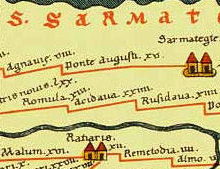Related Research Articles
Romula or Malva was an ancient city in Roman Dacia, later the village of Reşca, Dobrosloveni Commune, Olt County, Romania. It was the capital of Dacia Malvensis, one of the three subdivisions of the province of Dacia.
Dicaea or Dikaia, also called Dikaiopolis was a Greek port town on the coast of ancient Thrace on Lake Bistonis, in the country of the Bistones. Stephanus of Byzantium wrote that it took its name from the Dicaeus who was son of Poseidon.

Aiadava was a Dacian town in the Remesiana region, present day Bela Palanka, Serbia.

Acidava (Acidaua) was a Dacian and later Roman fortress on the Olt river near the lower Danube. The settlements remains are located in today's Enoşeşti, Olt County, Oltenia, Romania.
Bregedava was a Dacian town.
Carsidava was a Dacian town. Recent research placed Carsidava near Soroca town in Moldova
Clepidava was a Dacian town.
Desudaba (Desudava?) was a Thracian town in the tribal district of Maedica, in ancient Macedonia. It was located 75 M.P. from Almana, on the Axius, where the mercenaries of the Gauls who had been summoned by Perseus of Macedon in the campaign of 168 BCE, took up their position. Writing the 19th century, William Martin Leake placed it at or near Kumanovo, on one of the confluents of the Upper Axius.
Itadava was a Dacian town, in the territory of the fortress with unknown name near Burgaraca.
Marcodava was a Dacian town, north-west of Apulon.
Nentidava was a Dacian town mentioned by Ptolemy.

Piroboridava was a Dacian town mentioned by Ptolemy, and archaeologically identified at Poiana, Galați, Romania. Second part name of the city Dacian dava shows significance of the tribal city.
Polondava was a Dacian town, north of Dinogetia.
Recidava was a Dacian town.
Sacidava was a Dacian town located between Cedonia and Apulon.

Sacidava (Sagadava) was a Dacian town in Moesia Inferior, today's Dunăreni, Constanţa, Romania.
Scaidava was a Dacian town between Iatrus and Trimammium (Ablanovo).
Tamasidava was a Dacian town mentioned by Ptolemy.
Keiladeva was a Dacian town mentioned in toponomastic inscriptions.
References
- ↑ Pliny. Naturalis Historia . Vol. 4.11.18.
- 1 2
 Smith, William, ed. (1854–1857). "Stabulum Diomedis". Dictionary of Greek and Roman Geography . London: John Murray.
Smith, William, ed. (1854–1857). "Stabulum Diomedis". Dictionary of Greek and Roman Geography . London: John Murray. - ↑ Pomponius Mela. De situ orbis. Vol. 2.2.8.
- ↑ William Hazlitt (1851). The Classical Gazetteer . Vol. p. 135.
- ↑ Martial, De nuptiis Philologiae et Mercurii, 6.657.
- ↑ Olteanu, Sorin. "Linguae Thraco-Daco-Moesorum - Toponyms Section". Linguae Thraco-Daco-Moesorum (in Romanian and English). Archived from the original on 16 July 2011. Retrieved 3 January 2010.
- 1 2 Richard Talbert, ed. (2000). Barrington Atlas of the Greek and Roman World . Princeton University Press. p. 51, and directory notes accompanying.
- ↑ Marcellinus Comes, 481.1.
![]() This article incorporates text from a publication now in the public domain : Smith, William, ed. (1854–1857). "Stabulum Diomedis". Dictionary of Greek and Roman Geography . London: John Murray.
This article incorporates text from a publication now in the public domain : Smith, William, ed. (1854–1857). "Stabulum Diomedis". Dictionary of Greek and Roman Geography . London: John Murray.